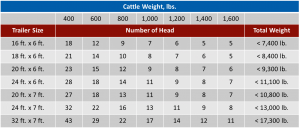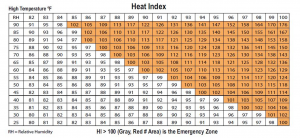Wisconsin’s soil types and weather patterns, which support the growth of a variety of forages, are ideal for raising cattle. We have two seasons (cold winter and hot summer) that do not support cattle very well, but in general, even those times are limited in the length of time during which cattle may struggle, with humid summer days having more of an impact on their well-being than January’s wind-chilled days.
Cattle prefer ambient temperatures of 55-60 °F, and they do not handle humidity very well. Their normal internal temperature is 101 °F. Their lung capacity is small in relation to their body size; so while panting helps, it may not be enough to cool them during hot, humid summer days. Their well-being especially suffers during humid days followed by evenings that do not drop below 70°F, as under those conditions, cattle will not have a chance to recover before the next hot, humid day begins.
Heat and humidity make transporting cattle especially stressful. Pay attention to weekly and daily weather forecasts and plan all hauling events accordingly, doing your best to avoid transporting cattle whenever possible during these times. If you must transport cattle, even for short trips between farm locations, keep hot weather transporting tips in mind.
Bear in mind the animals’ space requirements. Loading density charts, like the one included in this article, are available from BQA.org. (Click on image to make it larger.) Increase space per head during hot weather conditions to maximize air movement between them. Loading fewer cattle and making more trips is an economically superior outcome than having cattle suffer heat stroke during the trip.
When transporting on hot days, open all the trailer vents so there is plenty of air movement, and while driving the speed limit, make the trip as direct and efficient as possible. Make sure all animals are standing after being loaded and before starting out. It is best practice on long hauls to check animals after two hours on the road, and every four hours after that. If cattle must be hauled at times of hot temperature and humidity, avoid stopping and only stop if it is an absolute necessity. If possible, stop during the cooler parts of the day or park in the shade when stopped, and keep stops with cattle on the trailer as short as possible. Do not park near other vehicles as doing so prevents ventilation; try to allow cross breezes to pass through the trailer in hot weather.
Avoid hauling cattle when the heat index (HI) is in the extreme range, greater than 100 (orange areas on the HI chart included with this article) (Click on image to make it larger). Avoid hauling between 11 am and 4 pm. Early morning is the coolest time to haul, assuming it followed a cool evening. There really is not a good time to haul during stretches of hot, humid days and nights; if possible, postpone transport until the weather breaks.
Cattle find transportation stressful, and in response, their internal temperature naturally increases a few degrees. Physiologically, it takes them three to four hours to lower their temperature from its peak. So think about what ‘early morning hauling’ really means. During some hot, humid Wisconsin days, the extreme HI may begin by 11 am. Plan transport so that cattle’s internal stress response temperature is not peaking or coinciding when the HI is extreme. Ideally, they should be out of the trailer, relaxing in shade around full water troughs, naturally bringing their internal temperature down hours before the HI reaches extreme levels.
Source: fyi.uwex.edu











